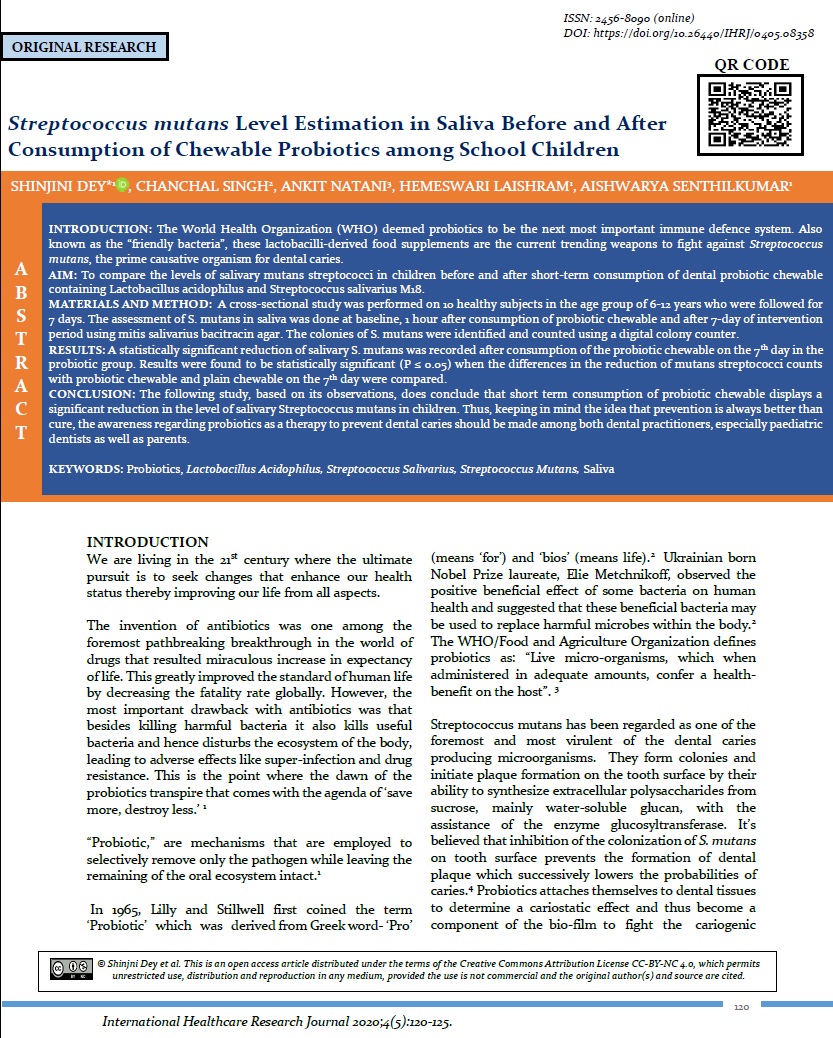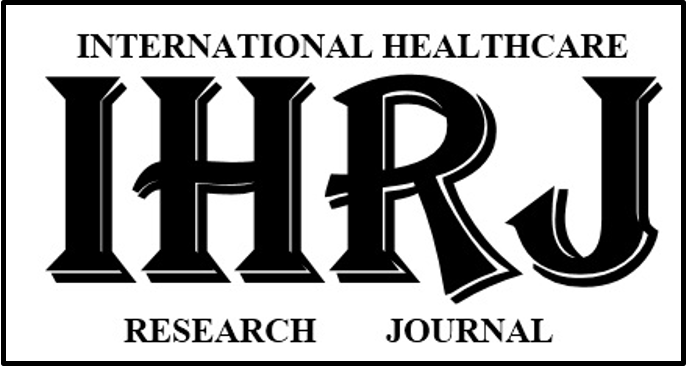Streptococcus mutans Level Estimation in Saliva before and after Consumption of Chewable Probiotics among School Children
Abstract
INTRODUCTION: The World Health Organization (WHO) deemed probiotics to be the next most important immune defence system. Also known as the “friendly bacteria”, these lactobacilli-derived food supplements are the current trending weapons to fight against Streptococcus mutans, the prime causative organism for dental caries.
AIM: To compare the levels of salivary mutans streptococci in children before and after short-term consumption of dental probiotic chewable containing Lactobacillus acidophilus and Streptococcus salivarius M18.
MATERIALS AND METHOD: A cross-sectional study was performed on 10 healthy subjects in the age group of 6-12 years who were followed for 7 days. The assessment of S. mutans in saliva was done at baseline, 1 hour after consumption of probiotic chewable and after 7-day of intervention period using mitis salivarius bacitracin agar. The colonies of S. mutans were identified and counted using a digital colony counter.
RESULTS: A statistically significant reduction of salivary S. mutans was recorded after consumption of the probiotic chewable on the 7th day in the probiotic group. Results were found to be statistically significant (P ≤ 0.05) when the differences in the reduction of mutans streptococci counts with probiotic chewable and plain chewable on the 7th day were compared.
CONCLUSION: The following study, based on its observations, does conclude that short term consumption of probiotic chewable displays a significant reduction in the level of salivary Streptococcus mutans in children. Thus, keeping in mind the idea that prevention is always better than cure, the awareness regarding probiotics as a therapy to prevent dental caries should be made among both dental practitioners, especially paediatric dentists as well as parents.
Downloads
References
Dash TR, Verma T, Suvarna M, Ghosh S, Singh N, Pradhan A. Probiotics and Oral Health. Int J Oral Health Med Res 2015;2(2):123-5.
Sareen M, Roy S, Singh SK, Gupta A. A review on probiotics and their implications in dentistry. Journal of Dental Sciences 2012;1(2):7-10.
Hill C, Guarner F, Reid G, Gibson GR, Merenstein DJ, Bruno Pot, et al. The International Scientific Association for Probiotics and Prebiotics consensus statement on the scope and appropriate use of the term probiotic. Nat Rev Gastroenterol Hepatol. 2014;11(8):506-14. http://dx.doi.org/10.1038/nrgastro.2014.66.
Dhawan R, Dhawan S. Role of probiotics on oral health: A randomized, double-blind, placebo-controlled study. J Interdiscip Dent. 2013; 3:71-8
Singh K, Kallali B, Kumar A, Thaker V. Probiotics: A review. Asian Pacific Journal of Tropical Biomedicine 2011;1:S287–S290.
Siddiqui M, Singh C, Masih U, Chaudhry K, Hegde DY, Gojanur S. Evaluation of Streptococcus mutans levels in saliva before and after consumption of probiotic milk: A clinical study. J Int Oral Health. 2016;8(2):195–8.
Broekaert IJ, Walker WA. Probiotics and chronic disease. J Clin Gastroenterol. 2006;40:270-4.
Allaker RP, Stephen AS. Use of probiotics and oral health. Curr Oral Health Rep. 2017;4:309-18.
Bhalla M, Ingle NA, Kaur N, Yadav P. Mutans streptococci estimation in saliva before and after consumption of probiotic curd among school children. J Int Soc Prev Community Dent. 2015;5(1):3134
Caglar E, Kuscu OO, Cilder SK, Kuvvetli SS, Sandali N. A probiotic lozenge administered medical device and its effect on salivary mutans streptococci and lactobacilli. Int J Paediatr Dent. 2008;18(1):35-9.
Wan AK, Seow WK, Walsh LJ, Bird PS. Comparison of five selective media for the growth and enumeration of Streptococcus mutans. Aust Dent J 2002;47(1):21-6.
Grover HS, Luthra S. Probiotics: The nano soldiers of oral health. J Indian Acad Clin Med 2011;13(1): s48-54.
Ishihara K, Miyakawa H, Hasegawa A, Takazoe I, Kawai Y. Growth Inhibition of Streptococcus Mutans by Cellular Extracts of Human Intestinal Lactic Acid Bacteria. Infection and Immunity 1985;49692-694.
Hatakka K, Savilahti E, Pönkä A, Meurman JH, Poussa T, Näse L, et al. Effect of long term consumption of probiotic milk on infections in children attending day care centers: Double blind, randomised trial. Br Med J. 2001; 322:1327
Di Pierro F, Zanvit A, Nabili P, Risso P, Fornaini C. Cariogram outcome after 90 days of oral treatment with Streptococcus salivarius M18 in children at high risk for dental caries: results of a randomized, controlled study. Clin Cosmet Investig Dent. 2015;7:107-3.
Sudha P, Bhasin S, Anegundi RT. Prevalence of dental caries among 5-13-year-old children of Mangalore city. J Indian Soc Pedod Prev Dent. 2005;23(2):74-9.
Kavitha M, Prathima G S, Kayalvizhi G, Sanguida A, Ezhumalai G, Ramesh V. Evaluation of Streptococcus mutans serotype e, f and k in saliva samples of 6-12-year-old school children before and after a short-term daily intake of the probiotic lozenge. J Indian Soc Pedod Prev Dent. 2019; 37:67-74.
Chinnappa A, Konde H, Konde S, Raj S, Beena JP. Probiotics for future caries control: A short-term clinical study. Indian J Dent Res. 2013;24(5):547-9.
Caglar E, Sandalli N, Twetman S, Kavaloglu S, Ergeneli S, Selvi S. Effect of yogurt with Bifidobacterium DN-173 010 on salivary mutans streptococci and lactobacilli in young adults. Acta Odontol Scand. 2005;63:317–20.
Cildir SK, Germec D, Sandalli N, Ozdemir FI, Arun T, Twetman S, et al. Reduction of salivary mutans streptococci in orthodontic patients during daily consumption of yoghurt containing probiotic bacteria. Eur J Orthod. 2009;31:407–11.
Ahola AJ, Yli-Knuuttila H, Suomalainen T, Poussa T, Ahlström A, Meurman JH, et al. Short-term consumption of probiotic-containing cheese and its effect on dental caries risk factors. Arch Oral Biol. 2002;47(11):799-804.
Jindal G, Pandey RK, Agarwal J, Singh M. A comparative evaluation of probiotics on salivary mutans streptococci counts in Indian children. Eur Arch Paediatr Dent 2011;12(4):211-5.
Singh RP, Damle SG, Chawla A. Salivary mutans streptococci and lactobacilli modulations in young children on consumption of probiotic ice-cream containing Bifidobacterium lactis Bb12 and Lactobacillus acidophilus La5. Acta Odontol Scand. 2011;69(6):389-94.
Chuang LC, Huang CS, Ou-Yang LW, Lin SY. Probiotic Lactobacillus paracasei effect on cariogenic bacterial flora. Clin Oral Investig. 2011;15(4):471-6.

Copyright (c) 2020 Shinjini Dey et al.

This work is licensed under a Creative Commons Attribution-NonCommercial 4.0 International License.


